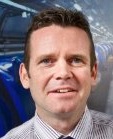How does recruitment work at the world’s most famous particle physics laboratory?
1) Does the recruitment and talent identification process change when you are recruiting for extremely high-profile projects e.g. the Large Hadron Collider (LHC)?
James Purvis in 15 seconds

James Purvis is Head of Talent Acquisition at CERN.
He is fully responsible for all recruitment & selection processes, and recruitment programmes from interns through to graduates and permanent positions.
He has been at CERN since 1989 in a variety of positions including as a Technical Student and Software Engineer before moving into HR.
He speaks English, French and Spanish and has a first-class honours degree in computer science from Brunel University.
The recruitment needs for LHC are certainly different from the previous machine (the Large Electron–Positron Collider) because the strategy of the organisation in building these projects changed significantly.
Previously CERN used to recruit the skills to carry out almost everything ‘in-house’, whereas the LHC was built a lot more collaboratively with partnerships in industry. The recruitment strategy needs to constantly adapt to the changing needs of the organisation – balancing a mix of in-house grown talent with recruitments from high-tech sectors.
You may be surprised but CERN recruits predominantly engineers (as well as a lot of technicians) and predominantly coming from the private sector.
2) How do you differentiate between potential applicants where the difference in aptitude may be extremely small?
For us its always a pleasure when we hold a recruitment and realise we have found potentially several candidates which could meet the requirements.
The difference then really focusses on the behavioural competencies which can be as important as the technical competencies for many roles. Being technically excellent is indispensable – but being able to communicate well and work in a team can be as equally vital to the success of the large scale projects at CERN.
3) How would you describe the culture at CERN?
Collaborative. Diverse. Unique. CERN has a ‘campus’ feel – like a university – with large on-site restaurants, post-office, travel agency, etc. Successes are achieved through collaboration and teamwork. Management supports and creates the conditions in which the employees will work to their best abilities. Nobel-laureates, technicians, physicists and engineers will all meet to discuss, collaborate and form ideas on how to solve the challenges at hand.
If you had to identify the area where some of the most important design decisions were made at CERN – from the design of the LHC through to the invention of the WWW or Nobel-prize winning ideas – it was probably the CERN cafeteria.
What is CERN?

The European Organization for Nuclear Research – the English translation of the French name Organisation Européenne pour la Recherche Nucléaire – aims to operate the world’s largest particle physics research lab.
It is probably best known for the Large Hadron Collider, a massive particle accelerator built beneath the Franco-Swiss border.
The LHC helps scientists test predictions in particle physics by accelerating particles to enormous speeds before colliding them.
The LHC was built in collaboration with more than 10,000 engineers and computer scientists across 100 countries.
The world wide web was also invented at CERN by British computer scientist Tim Berners-Lee in 1989.
4) You spoke a while ago on ‘bringing science to talent acquisition.’ How do you do this?
By using data & metrics and constantly questioning & re-evaluating the processes to say ‘how can we do this better?’
Multi-posting job adverts brings data to the decision makers when it comes time to renew job board descriptions. Asynchronous video screening allows us to more cost-effectively manage who we invite to on-site interview.
Technical testing allows for unbiased comparisons across the technical competencies of candidates. KPIs and automated reports tell us the recruitment channels and countries to target our efforts.
Even small habits such as the recruiters using Gannt charts to plan out their recruitment schedules like a project professionalises the approach in an engineering environment.
5) What are the biggest misconceptions applicants have about CERN?
Applicants think you have to be a physicist to work at CERN – or at least have a PhD. Both are wrong. That’s akin to thinking only astronauts work at NASA or British Airways only employ pilots. Only 3% of CERN’s hires are physicists and almost 50% of CERN’s hires don’t require a university degree.
6) What three things/goals/KPIs are your bosses looking for you to achieve in your role at CERN’s Head of Talent Acquisition?
Traditionally it’s time, quality and cost. For us cost is fixed and limited which is why we have a 100% direct hire model so our three KPIs are really quality, diversity and time. Diversity particularly in the nationality representation of CERN – fortunately we don’t have quotas – but with 21 member states we need to ensure fair returns across the countries as best as possible in addition to having the best possible person available in time.
7) What are the three main ‘soft skills’ you look for in applicants?
CERN has a comprehensive competency model and a strong focus on behavioural competencies (in additional to the technical) so all VNs describe the soft-skills we are seeking. I would say the main behavioural competencies are around ‘managing self’ (the ability to work autonomously, take initiative etc), communicating effectively (as collaboration is key at CERN), and team work.






